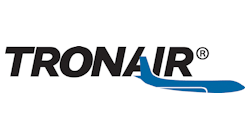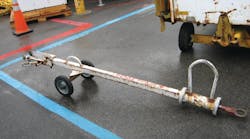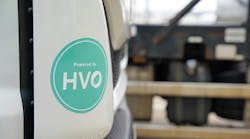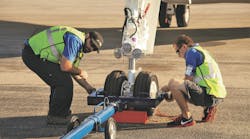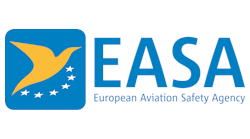January 2004
Poorly maintained and improperly used equipment can have
costly or even disastrous consequences, a good mechanical maintenance program
is a priority to ensure safety of personnel and prevent damage to the equipment
on the aircraft.
When using any type of GSE equipment, there are basic procedures that are the
foundation for any good mechanical maintenance program. These include performing
visual inspections; using and maintaining equipment per manufacturer's instructions;
and maintaining accurate maintenance records. When followed, these procedures
not only promote safety, but save both time and money. This article will discuss
the specific application of these fundamental procedures to the use of towbars,
tailstands, work stands, jacks, and engine slings/lifts.
Towbar Inspection
Prior to every use of a towbar, it is important to first verify that you are using the correct towbar and head for the type of aircraft that is being moved. Then, a visual inspection of the towbar continues by examining the following areas prior to every use.
- Inspect the towbar itself. Are there any bolts or pins missing that need to be replaced?
- Check for any loose bolts. Is the towbar straight and the head securely attached?
- Are the tires inflated to the proper pressure and do they show any abnormal wear? This is also a good time to grease the axles and bearings.
- Verify the shear pin is not broken or that the shear pin bushings are not cracked.
This inspection should be performed every time you use the towbar and the results should be recorded in your preventative maintenance log.
Towbar Usage
It is also important to verify that the towbar is sized properly for both the
aircraft to be moved and the tug that is going to be doing the moving.
- Make certain the towbar is securely connected to the aircraft. The towbar should be as close to horizontal as possible.
- The angle between the tug and the towbar should be roughly 90 degrees. Damage to the towbar can result from pushing the aircraft with the towbar jackknifed to the tug.
- Moving an aircraft safely requires two people.
- Correctly size the towing eye for the pintle hook used on the tug.
- Match pintle hook and towbar eyebolt.
Jack Stabilizing Stands (Tailstands)
When using a tailstand, it is important to have the correct tailstand mate to the aircraft fuselage to prevent damage to the aircraft. Some aircraft manufacturers have weight limits that cannot be exceeded, so specially designed alarming tailstands have been developed to notify mechanics if an overloading situation exists.
Maintenance of tailstands is very basic. The neck should slide smoothly up and down in the stand. The stabilizing pin should be inspected prior to use for unusual wear or bending. If signs of either exist, purchase the recommended replacement pin.
Work Stands
When it comes to the maintenance of work stands, there are procedures that need to be followed prior to every use, as well as procedures that need to be observed on a periodic basis.
Visual Inspection
A visual inspection should be conducted prior to each use of a work stand:
- Ensure that all components are present, secure, and operational (casters, handles, handrails, safety chains, lock pins, etc.).
- Inspect the frame to ensure that it is sound and free of damage (check welds, support tubes, and base supports).
- Check the load rating and be certain never to exceed it.
- Check all hydraulic components for seepage and leaks; check hoses for damage to make certain there are no pinch areas throughout stand operation; NEVER use if a hydraulic leak is found.
- Ensure that safety stops are present, functional, and show no signs of damage.
- Inspect the platform and steps to see that they are free of debris or slippery contaminates (oil, hydraulic fluid, cleaning chemicals, etc.).
- Ensure that aircraft protection bumpers are in place and are not damaged.
Periodic Maintenance (Semi-annual)
- Lube casters and hinge points.
- Ensure all casters are present and secure.
- Check fluid levels in hydraulic systems.
- Test operation in a controlled environment. Ensure stand has a full range of motion. Test safety stops for effectiveness.
Jacks
Jacks are essential components for any aircraft ground support maintenance program. Understanding the different types of jacks is key to proper maintenance:
1. Axle jacks are used for tire repair and replacement and are placed directly on or under landing gear of aircraft.
2. Tripod jacks are used on both the nose and the fuselage for routine maintenance.
3. Collapsible, portable tripod jacks are used mainly in the military.
Many jacks are interchangeable provided the correct jack pad for the specific aircraft is available.
Pump Inspection
The hand or pneumatic pumps should always be reviewed prior to operation. Determine if there are any leaks at the fittings on the hose or pump. Check the relief valve setting and operation. It is not uncommon to change the relief valve setting on the pump and have adverse effects to its operation. If a pneumatic manifold system is used, make sure the incoming or external line and system are sized properly to handle the manifold system flow. Verify the three jacks hoses are free and clear of obstructions and connected correctly.
Locknuts
Many jack's locknuts have knurled surfaces that are slow and uncomfortable to operate. The jacks should be inspected prior to use but every 90 days is the minimum. An annual load test and certification is also recommended.
Raising / Lowering Aircraft
Jacks should be run fully up and down before placing them under the aircraft. The proper process to raise and lower the aircraft should follow the aircraft manufacturer's recommended procedure. A typical procedure is as follows:
1. Lower the jacks to the minimum height.
2. Position the correct sized jacks and proper jack pad under the aircraft lift points.
3. Raise the mechanical extension up as close to the aircraft as possible.
4. Close the hand pump relief valve and operate the pumps in unison to ensure a level lift.
5. Lower the speed ram lockouts as the aircraft is raised. A stabilizing stand (tailstand) may be required at this point.
Storage
When storing a jack, it should be covered to prevent any water debris from getting into the ram piston assembly.
Engine Slings / Lifts Inspection
Prior to using any engine sling or lift, the following needs to be inspected:
- Missing parts (pins, fasteners, labels, etc.).
- Operation of all ball-lok pins & shackles.
- Inspect sling components for any signs of material deformation, cracks, or excessive wear.
- Loose bolts and fasteners.
- Cracked or excessively worn straps, bars and plates.
- Excessive wear at hoist points and load support clevis and pins.
Safety
As failure to properly use and maintain engine slings and hoists could result in serious personal injury or damage to equipment, operators should always follow good workmanship practices and exercise caution.
- NEVER exceed rated load or lift a load not intended for this sling.
- NEVER use sling if any damage or excessive wear is found.
- NEVER lift suspended loads over personnel.
- NEVER make any alterations or modifications to sling.
- ALWAYS stay clear of suspended loads.
Loads
- ALWAYS ensure engine is balanced on sling. If engine is unbalanced, check that the orientation of sling is correct. In the event of an unbalanced condition, loss of control and/or damage may occur to the engine along with injury to operator.
- NEVER use sling to lift personnel.
- NEVER leave suspended loads unattended.
- NEVER remove or obscure warning labels.
- DO NOT use sling until you have read and understood the user manual.
- NEVER lift loads higher than necessary.
- Slings should be load tested annually and records kept on testing. Consult manufacturers recommendations for testing weights.
Implementing these maintenance and safety guidelines not only promotes safety, but saves both time and money by preventing costly damage to equipment and aircraft. These simple and common sense mechanical maintenance procedures serve as the foundation for any good mechanical maintenance program.
5- Point Jack Inspection Prior to using any jack, a five-point inspection is recommended and must include the following: 1. Check for any bent or stressed components such as lugs. 2. All fluid levels must be verified and topped off, if required. 3. Check welded joints for signs of fatigue. 4. Are any components or parts missing or damaged? 5. Examine the condition of the locknuts.


